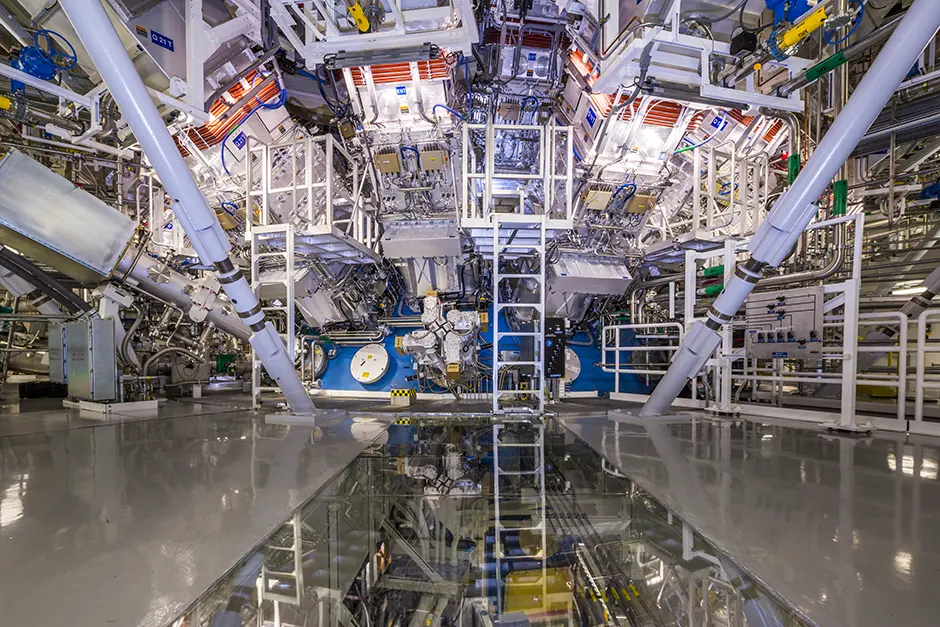In a milling process performed at the nanoscale, mechanical engineer Giacomo Po focuses a beam of ions onto an advanced metal alloy, shaping it into a form hundreds of times smaller than the width of a human hair and then examining it under a high-powered scanning electron microscope.
"We're interested in how the metal behaves under high stress and temperature," said Po, an associate professor at the University of Miami College of Engineering, as he looked at an image of the sample on a computer screen. "And by modifying the sample, we'll be able to see what happens to it at different stages of deformation."

It may seem incomprehensible, but the research Po is conducting on alloys at an infinitesimal level could one day help humankind achieve a gargantuan goal: replicating the same nuclear process that powers the sun.
"Fusion power is the holy grail—a dream that scientists have been chasing for decades," Po said of the quest for the nearly limitless, zero-carbon source of energy.
But to achieve it, scientists must overcome a multitude of challenges. Among them, finding metals and modifying them to withstand the extreme environments inside future fusion reactors, where temperatures would soar to tens of millions of degrees.
Tungsten, a refractory metal known for its exceptional hardness and high melting point, holds tremendous potential for surviving such harsh conditions and would most likely be the first layer of material used in a commercial fusion reactor. But deep inside the reactors, temperatures are just as harsh, necessitating the need for a new class of materials that can hold up to such conditions.
"So, we're delving deep into the study of high-entropy alloys," Po said.
Created by mixing equal or relatively large proportions of five or more elements, high-entropy alloys are known for their strength, hardness, resistance to corrosion, and high-temperature performance. But little is known about what is called their "irradiation creep" properties—a phenomenon in which materials deform over time under stress and exposure to radiation. "We need to know how long they can survive in a fusion reactor before they become brittle," Po said.
By using high-temperature deformation experiments inside a scanning electron microscope combined with computer modeling, Po and his team, which includes a group of Ph.D. students, are trying to find out.
"The advantage with this method is that we're able to rationalize what we've observed in experiments into models and equations, and then we test the models and experiments at the same scale," Po explained. "If the models hold up, then we'll get a better understanding of the alloys' performance and how we could potentially improve them."
A series of grants from the U.S. Department of Energy and the National Science Foundation CAREER Program supports Po's research.
"We're working on just one aspect of achieving fusion power. The challenges are numerous, and the quest is collaborative in nature," said Po, noting that teams of investigators across the world—from the U.S., China, and the European Union to Japan, India, and South Korea—are racing to accomplish the goal.
The capital being invested in the quest is staggering, with some estimates placing it at close to $10 billion in mostly private money being poured into fusion startups over the past four years.
Along the way, scientists have achieved several breakthroughs in fusion energy, placing the world closer to achieving the hard-to-reach source of power. Three years ago, for the first time ever, scientists at the National Ignition Facility at the Lawrence Livermore National Laboratory in California successfully produced a nuclear fusion reaction resulting in a net energy gain, producing more energy than was used to initiate it.

The National Ignition Facility Target Bay at the Lawrence Livermore National Laboratory in California is where a breakthrough in nuclear fusion was made. Photo: Damien Jemison/Lawrence Livermore National Laboratory
And just before it ceased operations at the end of 2023, the Joint European Torus, an enormous magnetic fusion research facility in the UK, sustained a record 69 megajoules of fusion energy for five seconds, using only 0.2 milligrams of fuel.
"Fusion power can literally change the world," Po said.
But don't confuse fusion with fission, the latter of which splits atoms and is the current process that powers today's nuclear plants but generates radioactive waste, Po cautioned.
"Instead, think of joining pieces together," he said. In nuclear fusion, two light atomic nuclei combine to form a single, heavier nucleus, releasing a prodigious amount of clean energy.
"Imagine an electric grid powered by a stable, low-cost, and abundant source of energy that doesn't rely on the burning of fossil fuels or the unpredictability of wind or solar energy. Electric vehicles with no or very little charging costs. The ability to purify water from the ocean, removing the salt," Po said. "That's the promise of fusion energy."






